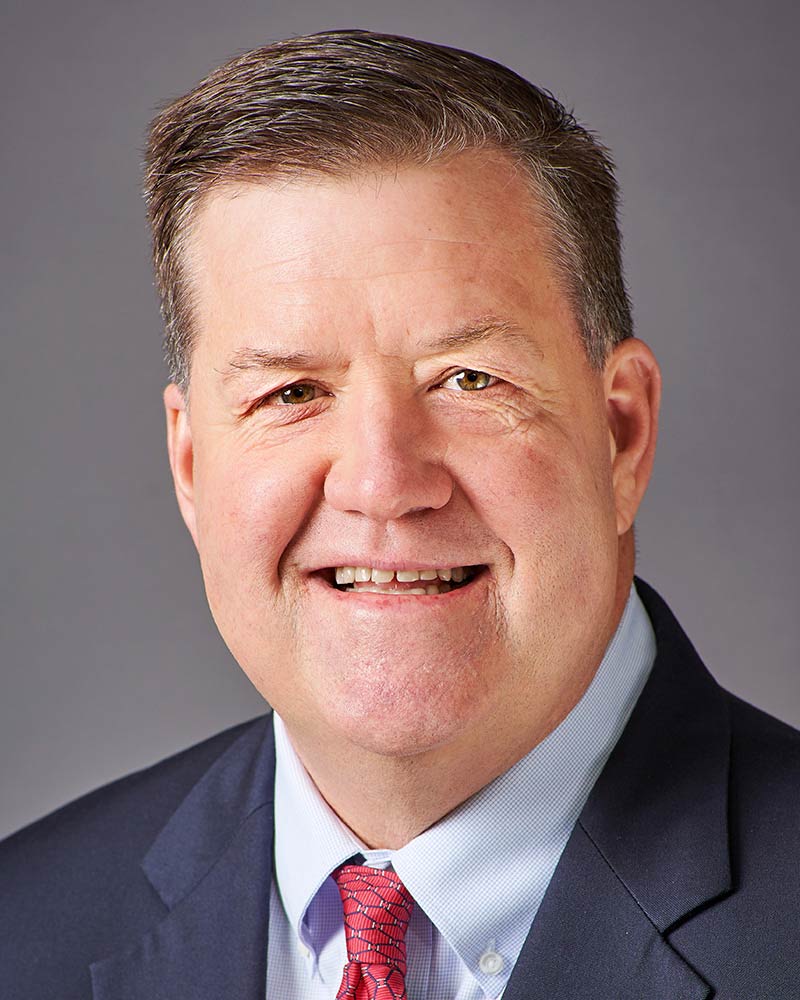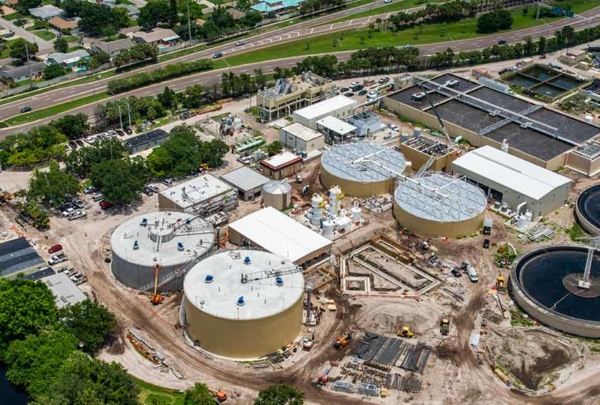Building the Future with an Innovative Approach to AEC Excellence
Learn how Haskell’s diverse, global team leads the AEC industry by continuously breaking new ground to deliver unmatched value and certainty for clients.
Walk the halls of Haskell’s Jacksonville, Florida, headquarters and you’ll see all the signs of a thriving design and construction company, as drafting tables and complex computerized models juxtapose with hardhats and transit levels.
To know Haskell is to know the spirit of innovation and the assurance of certainty that lie beneath. To know Haskell is to understand unrivaled client care, unparalleled high quality and global scale. But to really know Haskell is to know how deeply its more than 2,200 team members care for their customers, their colleagues and their communities.

From its first commercial construction contract, Haskell has been breaking new ground in the architectural, engineering and construction (AEC) world to create the greatest possible value for project owners. Design-build project delivery didn’t exist as a discipline in 1967, when The Preston H. Haskell Company contracted to build a 53,160-square-foot manufacturing plant for Covington Industries. Haskell’s newly formed team broke the mold, however, by producing the entire project, from concept to commissioning.
The idea was simple and elegant. A design-build contractor could act as a single point of contact – and a single party accountable to the project owner – providing clients certainty of outcome in budget, schedule and performance. Preston Haskell was an early proponent and became a leading evangelist for the design-build delivery method, which now accounts for nearly 50% of all construction spending in the United States.
In the more than almost six decades since, Haskell has shortened its name but grown in myriad ways.
Driven by its innovative spirit and relentless pursuit of optimal customer service, Haskell continued to lead the industry in adopting new project delivery methods. Its unique Permanent Craft Employee (PCE) program staffed crews that pioneered tilt-wall construction for greater efficiency. Its leadership team leveraged organic growth and acquisition to assemble the process, packaging and material handling expertise to put Haskell on the cutting edge of the turnkey Engineer Procure Construct (EPC) method of delivering solutions for manufacturing customers. Today, through Dysruptek, its innovation-focused venture capital arm, Haskell is scouting, piloting and investing in emerging technologies that stretch the status quo to provide clients with the greatest possible competitive advantage.
 “The foundation of Haskell is fantastic,” said Haskell Chairman, Chief Executive Officer (CEO) and President Jim O’Leary. “You’re talking about a place where you have high-quality top people in our industry; a place where you have one of the best reputations in the industry; a place where you have operational excellence and systems and everything in place to do well; a place where you have a broad customer base that is happy with what you’re doing. So, it’s all there; it’s all been there. It’s a foundation we can continue to build on.”
“The foundation of Haskell is fantastic,” said Haskell Chairman, Chief Executive Officer (CEO) and President Jim O’Leary. “You’re talking about a place where you have high-quality top people in our industry; a place where you have one of the best reputations in the industry; a place where you have operational excellence and systems and everything in place to do well; a place where you have a broad customer base that is happy with what you’re doing. So, it’s all there; it’s all been there. It’s a foundation we can continue to build on.”
Build, O’Leary and his team have done. Haskell has doubled its workforce and revenue since August 2018, when he became just the third CEO in the company’s history. More importantly, it has further laid a foundation for the future.
A Culture of Inclusion
O’Leary expanded the company’s top management, leveraging what had been the three-person Office of the Chief Executive to the eight-member Executive Leadership Team (ELT). Those eight leaders then thoughtfully created a strategic plan they called Haskell 2025, a set of goals, some operational and some aspirational, and a set of dynamic key initiatives designed to best serve clients and their 2,200-plus employee-owners alike. Indeed, the six pillars of Haskell 2025 start with a pledge to employees, who are known as team members:
- Provide team members with the BEST job of their lives.
- Drive operational excellence.
- Grow program management, consulting & design services.
- Optimize intellectual capital, technology and innovation.
- Expand diversity and inclusion.
- Achieve meaningful and profitable growth.
Instilling an inclusive culture prompted the ELT expansion, and in 2023, it led to an organizational transformation to an Enterprise Project Delivery Model (EPDM), unifying similar disciplines from across its legacy Consumer Packaged Goods (CPG), Infrastructure & Transportation (I&T), Design and Consulting Services (DCS), and International groups to form four new operating groups that serve all markets.
- Planning & Development (P&D)
- Construction & Manufacturing (C&M)
- Design & Consulting (D&C)
- International
In its first year, the new structure proved successful in meeting the goals of enhancing consistency, operational excellence, and improved career opportunities.
“Probably the largest accomplishment and the one that I’m most proud of is building culture and ingraining our core values of Team, Excellence, Service and Trust,” O’Leary said. “We have an environment of collaboration and transparent communication. This is just about us being open and honest and straightforward. We share. We share what we know when we know it. And that’s the way this organization is going to be.”
Since 2018, Haskell’s revenue has doubled to just shy of $2 billion, and its workforce has grown 40%. Ensuring that such expansion is meaningful and profitable has required planning, foresight and investment in several areas crucial to the entire AEC industry.
Learning, Development & Engagement (LD&E)
Historically, Haskell has been dedicated to professional development, but adequately training and engaging its fast-growing workforce, providing team members with the best jobs of their lives and driving operational excellence would require an even more concerted effort.
 “As we saw this growth, it was clearly important to provide more structured technical skills training to provide meaningful career development to our new team members,” said John-Paul Saenz, Haskell Executive Vice President and Chief Operating Officer (COO). “The approach of significantly investing in learning and development recognizes that we need dedicated operations resources and subject matter experts for consistent training platforms across the entire company.”
“As we saw this growth, it was clearly important to provide more structured technical skills training to provide meaningful career development to our new team members,” said John-Paul Saenz, Haskell Executive Vice President and Chief Operating Officer (COO). “The approach of significantly investing in learning and development recognizes that we need dedicated operations resources and subject matter experts for consistent training platforms across the entire company.”
With more than 20 offices in the United States, Asia-Pacific and Latin America and the size and scope of its projects growing steadily, it became apparent to ELT members that maintaining the quality, consistency and certainty of outcome clients expected would require a greater effort than ever. For example, a project manager hired in St. Louis, Missouri, needed the same onboarding, experience, and understanding of methods and expectations as a project manager hired in Mexico City or Singapore.
Haskell led craft development and cross-training through its revolutionary Permanent Craft Employee (PCE) program. Deep ties to science, technology, engineering and mathematics (STEM), Career and Technical Education (CTE) and apprenticeship programs have helped it develop the craft professionals of tomorrow.
But the educational commitment goes beyond the team of tradesmen. Professional education and development across all disciplines were identified as the key to supporting clients with consistent best-in-class performance as Haskell grew in scope and scale. Haskell University, the company’s Learning Management System, was overhauled to make the curricula more accessible and include features such as personalized subject interest tags and badges based on courses completed. New and upgraded courses, including timely and relevant subjects such as diversity and inclusion, design thinking, and mental health, allow employees to develop universally applicable workplace competencies.
This commitment and investment led Haskell to consecutive years in the No. 1 spot in Training Magazine’s APEX Awards rankings, an exclusive list of the leading training organizations worldwide. The company has appeared in the rankings for 12 consecutive years, climbing steadily. Reaching the pinnacle in the 2024 list marks the company’s fifth straight appearance in the Top 20, the fourth straight in the Top 10 and the third consecutive year in the Top 5.
“The LD&E team and Haskell’s training programs have found success because we align ourselves to Haskell’s business goals, making sure our approach to training is firmly rooted in Haskell 2025 and ensuring everything we do is supporting those six strategic pillars,” said LD&E Vice President Brooke Jones-Chinetti. “We’ve looked at what the company expects of its performance and of its team members, and we’ve tailored training to support that.“
Each year, Haskell partners with Gallup to administer its highly acclaimed Q12 Engagement Survey, which provides a snapshot of team members’ sentiments on 12 statements. The extensively researched surveys provide a snapshot of attitudes and inform action plans for improvement. In 2024, 55the company’s 9.33:1 ratio of engaged to disengaged team members far outpaces the global average of 4:1 for companies using the Q12 survey.
Safety
Across the industry, worker safety is an ongoing challenge. Since 2008, construction has experienced more total deaths than any other industry (and that figure doesn’t include fatalities from suicide — of which this industry also has the most). Construction professionals have higher injury rates than most other professions and experience some of the highest rates of alcohol abuse. And if they survive an entire career on the jobsite, workers can expect an increased risk of hearing impairment, mobility problems, and respiratory issues.
While other firms look to more frequent inspections, better safety guidelines and equipment, technology and certifications to rectify problems, Haskell proudly stands as an industry leader in safety, having received the ABC’s Pinnacle Award for Safety in three consecutive years and four of the past five.
“When we (visit job sites), the feedback you get is, ‘You can tell a Haskell project. It’s different from others we’ve worked on,’ man that’s rewarding,” said Lance Simons, VP of Safety and Quality. “Nothing is more rewarding than having a trade professional get engaged by leadership and say they work for other companies and know that on a Haskell project, safety is most important. That’s where we want to be. “f
Statistically, Haskell is measured against the commercial construction industry based on Total Recordable Incident Rate (TRIR), which the U.S. Bureau of Labor Statistics compiles. In 2023, Haskell team members recorded a TRIR of 0.39 while setting a company record with more than 4.6 million hours worked. This represents a performance 400% better than the industry average.
“It makes me extremely proud because the safety of our customers, our team members and our trade partners is absolutely the highest priority of this organization. It’s in our DNA. It’s an honor to be consistently recognized on an annual basis by ABC for safety. You can talk about safety compliance and safety results, but when it becomes part of your culture and who you are, that’s when it becomes special. And that’s where we are today as an organization.”
Sustainability
In its 2024 Engineering and Construction Industry Outlook, Deloitte Insights reports that the U.S. Green Building Council (USGBC) 2023 report, sustainability is a top priority for most surveyed AEC firms, as it aligns with their organizational mission and business strategies. Strategies such as reducing the embodied carbon of essential construction materials, passive design principles and using energy-efficient equipment can accelerate decarbonization by minimizing the overall carbon dioxide emissions associated with the construction and operation of a building.
As environmental concerns grow, sustainable construction practices are gaining momentum and attention. Green building materials, energy-efficient designs, and renewable energy integration are becoming standard features in modern construction projects.
With the growing adoption of efficient building materials and sustainable construction practices, the industry is expected to be better positioned to accelerate changes and align with the International Energy Agency’s Net Zero Emissions by 2050 Scenario, which requires all new buildings and 20% of existing structures to be zero-carbon-ready by 2030.
Haskell was an early adopter of sustainable design and construction. It joined the USGBC in 2001 and has built nearly 120 LEED-certified facilities. The long-established Haskell Sustainability Council includes several of the more than 100 sustainability-accredited professionals in the company. Haskell’s integrated delivery model naturally supports enhanced green design and construction throughout the project lifecycle, a focus that will only redouble as regulations and customer needs intensify.
 “Going forward, I think there’s going to be much more of an emphasis on how we minimize embodied carbon and get to a net-positive building where, in the lifespan of that building, five years, 10 years, 15 years out, it has actually produced less carbon than it created or caused,” said Frank Mangin, Design & Consulting Operations President. “At some point, it becomes a net-positive carbon building.”
“Going forward, I think there’s going to be much more of an emphasis on how we minimize embodied carbon and get to a net-positive building where, in the lifespan of that building, five years, 10 years, 15 years out, it has actually produced less carbon than it created or caused,” said Frank Mangin, Design & Consulting Operations President. “At some point, it becomes a net-positive carbon building.”
Technology Adoption
From 3D printing to robotics to artificial intelligence (AI), construction technology has changed the industry forever. It’s allowed for greater efficiency when building, streamlined project management and more transparent surveying, greatly benefiting a business’s bottom line.
The construction industry is the second least digitized industry, but it won’t stay that way long. In 2023, around a third of construction companies reported using AI and prefabrication technology in the previous 12 months, and 40% of industry professionals plan to purchase or upgrade their construction management software in the next year. Both numbers are expected to accelerate in 2024.
Haskell counts among its strategic pillars the goal of optimizing intellectual capital, technology and innovation. To that end, it created Dysruptek, its venture arm dedicated to scouting, piloting and investing in emerging technologies and capitalizing on the innovations born within its diverse employee base.
Global insurance carrier AXA XL ranks Haskell No. 1 in its Technology Adoption Maturity Index (TAMI). The second annual designation celebrates Haskell’s leadership in embracing innovation and adopting technology solutions.
Not surprisingly, the top two entries in the fourth annual Big Pitch, Dysruptek’s Shark Tank-styled competition, harness artificial intelligence (AI) to address pain points in the project lifecycle. Each team received a cash award, funding and support to develop their innovations.
The winner, Smart Blocks, will use generative design to provide coordinated and detailed designs with faster and more accurate cost estimates during the preconstruction phase. Runner-up Load Builder envisions AI-powered software to revolutionize shipping logistics for Haskell Steel, which fabricates and ships thousands of tons of steel annually.
Fortifying the Future
Haskell operates more than 20 offices in the United States, Latin America and the Asia-Pacific region and, at any given time, 100 or more job sites worldwide. It offers the familiarity of a local project delivery firm with global scale.
Its history of innovation and accomplishment pairs with a rock-solid balance sheet. It is a trusted partner to many of the world’s best-known brands and cutting-edge startups in diverse markets, offering a disciplined approach to meeting client needs through its in-house, integrated service offering. It is committed to purposefully nurturing an inclusive and transparent culture and championing the aggressive implementation of the most advanced technology.
As has been the case since its founding, Haskell’s strategic moves, acquisitions and innovations are centered on better serving its customers, whether that means growing existing relationships or forming new ones.
“We can differentiate ourselves by being real partners around really digging in and understanding what their challenges in this new world are,” O’Leary said. “We want to approach it in our traditional manner of getting in and building a relationship, trying to understand what their needs are and responding to it.”
But Haskell’s leaders also have another constituency in mind as they chart the company’s cultural and operational future: The Haskell team members of the future. Every aspect of the company is viewed considering the AEC industry’s intense competition for top talent.
In the aggregate, Saenz said he trusted that the company presented an attractive environment.

“There’s a lot of opportunity created by the way we’ve structured the company and what we’ve decided to focus on, whether it’s technology, whether it’s a geographic diversity, a market diversity and then the organization itself, being mindful of how large we are and how large we are going to continue to become,” he said. “We’ve made it to where it does create opportunities for a lot of people to take leadership positions.”
In a challenging business environment, to know Haskell is to know that the present is solid and the future gleams.
“Somebody asked me not long ago if I could sum up all of this that we’ve gone through and where we’re at today,” O’Leary said. “It just came to me right away and I said what it proved to me is that Haskell’s built to last, absolutely built to last.”














